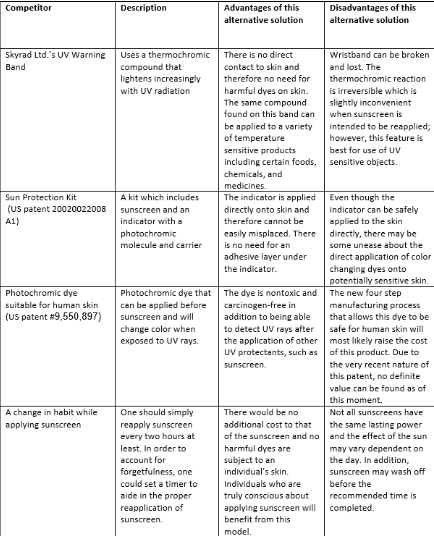BME100 s2017:Group2 W1030AM L1
| Home People Lab Write-Up 1 | Lab Write-Up 2 | Lab Write-Up 3 Lab Write-Up 4 | Lab Write-Up 5 | Lab Write-Up 6 Course Logistics For Instructors Photos Wiki Editing Help | |||||||
OUR TEAM
LAB 1 WRITE-UPHealth Care IssueThe health care issue we are focusing on is skin cancer. There are three main types of skin cancer, and they are all believed to be caused by overexposure to the sun (UV rays). This typically happens when people get sunburns, which damages the skin. A repeated occurrence of this will make it more likely for a person to get skin cancer. But you can also develop skin cancer even when you don’t get frequent sunburns. Skin cancer is the result of too much UV radiation, which can also happen with the use of tanning beds. Our device will look at preventing skin cancer. There are already products out there that attempt to do this (sunscreen), yet more people get skin cancer than any other type of cancer. This is largely because they overestimate the power of sunscreen. Many people put it on once and stay out in the sun without ever reapplying their sunscreen when they should. Our product will try to help people remember to reapply their sunscreen. We intend on having them apply our product along with their sunscreen. It is a photochromic dye, and when it is first applied, it will be a bright color that will fade over time to tell you that you need to put on more. So when it has been exposed to the sun long enough, it will fade or if it gets washed off, it will also fade. We hope this will prevent the incidents of skin cancer if people are more conscious about their use of sunscreen.
Armstrong, Bruce and Anne Kricker. “The epidemiology of UV induced skin cancer”. Journal of Photochemistry and Photobiology,
“Skin Cancer Facts & Statistics“. Skin Cancer Foundation, http://www.skincancer.org/skin-cancer-information/skin-cancer-facts,
Customer ValidationLiana R (ASU undergraduate student): “Honestly, I don’t care. I don’t use any such products.”
CompetitorsIP PositionA patent for using photochromic dyes in sunscreen was issued on January 24, 2017, with the patent number 9,550,897. Specifically, the patent introduces a procedure to remove toxic substances in the photochromic dye proposed. The patent’s assignee is GENESIS LABORATORIES, INC. in Carrollton, TX. Similar patents have already been in existence. For instance, a patent filed in 2001, titled “UV indicator to signal the reduction of sunscreen efficiency” (#US20020022008 A1), includes a “sun protection kit [which] comprises a sunscreen and an indicator that alerts a user when the sunscreen is no longer providing sufficient UV protection and needs to be reapplied”. The patent also proposed the inclusion of photochromic dyes as indicators. A variety of functions have been packaged in with sunscreen. For instance, the patent #US20140161846 A1, “Sunscreen with cooling agent” was filed in 2012, and proposed a sunscreen to include a mechanism for a cooling agent in sunscreen. Multi-functional products have become more common, and this has translated to many sunscreen additions. Another multi-functional sunscreen that has been on the market is “Sunscreen with disappearing color indicator” (#US6290936 B1). Filed in 1997, the patent proposed a sunscreen, whose color disappears after rubbing, to ensure a more uniform coverage of the sunscreen on the human body. Very many patents have been filed for similar effects, involving sunscreen and color indicator that shows which parts of the body have not been covered with the sunscreen. Waterproof sunscreen patent was filed in 1986 (#US4731242 A). The patent, “Waterproof sunscreen compositions,” proposed a sunscreen “with increased [which] would provide for protection against tanning from the solar spectrum in regions extending beyond the conventional ultraviolet region of conventional sunscreens”. An abundance of color-based sunscreen composition patents exist. For instance, “Colored sunscreen compositions” patent (#EP1399123 A2) proposes a composition of sunscreen that improves “retention of sunblock and coloring agents on the skin”. Fundability Worksheet ScoresCompetitors: 2 - The competition is there. There are other companies involved, but there’s still enough wiggle room for another one to start up and be okay. Customer Validation: 1 - It seems that the cost weighs in heavily as to whether product would be bought or not. Some customers feel it a hassle more than not, so there is some hesitation. IP Position: 0 - A recent patent (within the last week or two even) prevents us from creating a photochromic dye useable on human skin. There have also been several patents already issued for similar products, leaving us little to no wiggle room on new patentability.
| |||||||

